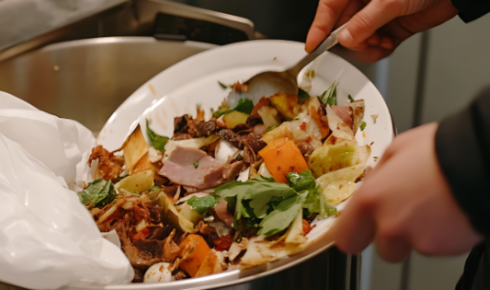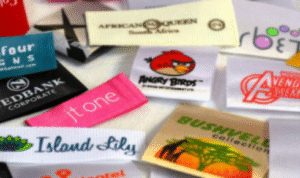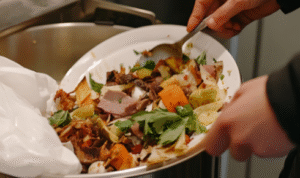
What if every third plate of food prepared in your restaurant ended up in the trash?
Food waste isn’t just your kitchen’s concern; it’s a moral, financial, and environmental crisis affecting the entire U.S. economy.
Every year, U.S. restaurants throw away over a billion pounds of edible food, which is nearly 30% of what’s prepared.
That waste doesn’t just hit trash, it drains an estimated $162 billion from the industry and exacerbates the country’s hunger crisis.
In 2023 alone, more than 18 million Americans faced food insecurity.
It’s a staggering reality, and one your restaurant has the power to change.
But before we dive into how to prevent food waste in restaurants, let’s dig into why this wastage happens.
Why Does Food Waste Happen?
A lot of food waste occurs in the US because of these reasons:
Bigger Resource Sizes
When you are buying raw produce for your restaurant, it comes in large sizes, making it difficult to consume it all.
Restaurants aren’t Allowed to Keep Items Beyond the Expiry Date
A lot of food is thrown away because, as per public health regulations, this food can’t be used beyond its expiry date.
Uneducated Restaurants About Portion Control
You may serve consumers with a greater portion than they can consume. This leads to food wastage, where 30-40% of food is left unconsumed.
Pre-Served Food Wastage
Food is wasted due to overproduction, burning, or bad taste. This is pre-consumer waste, leading to 4% to 10% restaurant food waste.
Post-Served Food Wastage
When food is served to consumers and they leave it on the plate, it leads to 17% of the served food being wasted.
10 Practical Strategies on How to Prevent Food Waste in Restaurants and Drive Sustainability
Now we know some prominent reasons why it happens, let’s delve into how to prevent food waste in restaurants.
Conduct a Food Waste Audit
To prevent food waste, the best-fit strategy is to dive into an audit. Different types of wastage under this audit are:
- Spoilage waste
- Overproduction
- Plate waste
- Custom orders gone wrong
- Single-use containers
As a step-by-step process, to conduct an audit, you can measure your trash before you hand it over for pickup.
- Have your team open the trash can each day
- Measure what ingredients, veggies, or poultry in perfect condition are being trashed
- Multiply each category by days your restaurant is open yearly
- This gives an estimate of what produce is being wasted each year.
The heavily wasted items can be managed, for e.g., heavy meat waste can be used in broth, and heavy veggies can be incorporated into stock.
Improve Inventory Management
The biggest drain on a restaurant’s profit is wasted ingredients.
A good restaurant back-of-house software tracks what ingredients are coming in, what’s being used, and what’s tossed out. Instead of just guessing or counting manually, you get an exact measurement with BoH software.
If you have a smart kitchen display system that cleanly connects front-of-house (FoH) and BoH, each order flows seamlessly between front and back. No more under- or overproduction, no missed orders, and minimum food wastage.
Optimize Menu Planning
You may lose out on food wastage, not because of bad food, but due to poor menu engineering.
A few common fallouts in menu engineering are due to:
- Pricing only targets food costs and not on-demand and psychological factors.
- Keeping underperforming items on the menu.
- Not promoting high-profit dishes effectively.
A well-optimized menu can raise profit by 10-15% without additional costs.
Train and Engage Staff
Train new hires on how to prevent food waste. Waste encountered during food preparation is one of the highest reasons for food wastage; therefore, training staff on how to prevent food waste in restaurants is crucial.
Manage Portion Sizes and Offer Choices
In restaurants, food leftover due to high portion sizes is humongous.
With a smart POS, you can offer lower portion sizes as an option. If you are selling coffee, you can provide tall, large, and grande sizes at different prices and avoid wastage.
To back up, portion size is crucial because in the US, this size is two to eight times bigger than the USDA or FDA standard servings.
Leverage Technology
Restaurant technology companies help with insights into inventory management, POS software, BoH and FoH management, kitchen display systems, and menu engineering.
It helps identify the most popular dishes, track stock levels, get insight into waste trends, and standardize portion sizes.
These companies also help adjust pricing in real-time for items nearing spoilage and promote daily specials via social media handles to use up excess ingredients. They aid in streamlining kitchen communication and reduce order errors to avoid food waste from miscommunication.
Donate or Repurpose Excess Food
You can use leftover ingredients or meals for staff meals or specials.
If you are combating the utilization of leftover or unused ingredients or food, you can connect with local charities. In case this isn’t a feasible option, with Sustainable America’s food rescue locator, connect with local businesses specializing in food distribution in your ZIP code.
Seasonal Menus
The seasonal ingredients are easily available in abundance and lower price. They are easy to store and rarely spoil due to the rotating menu.
Seasonal menu planning encourages cross-utilization of ingredients across dishes, minimizing leftover raw materials, e.g., butternut squash used in soups, risottos, and side dishes.
By adhering to a rotating menu, you can prepare in smaller batches and reduce the risk of wastage.
Promote Takeaways and Leftovers
Encouraging customers to take away leftovers aligns with eco-friendly practices and dining trends.
You can add a note on the menu – “Can’t finish your meals? We’ll pack it for you.” This normalizes diners asking to pack leftovers without feeling awkward.
Also, use digital boards to offer discounted takeaway meals at the end of the day. Add note – “Taking leftover meals at home will contribute to an eco-friendly waste-reduction strategy.”
Track Progress Over Time
Reducing wastage isn’t a one-time process. It requires continuous monitoring, effort, and reflection.
Use your POS to track:
- Waste volume (daily/weekly) by category.
- Cost savings (before and after waste reduction efforts)
- Sustainability effort (reduced carbon footprint, water savings and meals donated)
Celebrate your team for reducing waste over a time period and reward them with incentives. Share this achievement over social media to boost morale.
Leveraging POS Can Lead to Sustainability and Economic Freedom with Lowered Food Wastage
Reducing food waste isn’t just about environmental benefits–it’s also a smart business move. It lowers operational costs by preventing over-purchasing or delivering large portion sizes and ingredient spoilage.
This leads to higher profit margins as optimized menus and data-driven decisions eliminate low-performing items from the menu. This focuses on customer favorites, increasing sales without additional costs. Offering portion size options, encouraging leftovers, and promoting sustainable practices enhancethe dining experience and foster brand loyalty.
This also adds further value to environmentally friendly dining. It starts with conducting regular food waste audits using integrated POS systems like NOVA. With insights from sales and inventory data, restaurants can make informed adjustments in menu planning, purchasing, and staff training.
While it is a preferred all-in-one POS, learn how NOVA helps restaurants reduce food waste with smart inventory and kitchen management.







